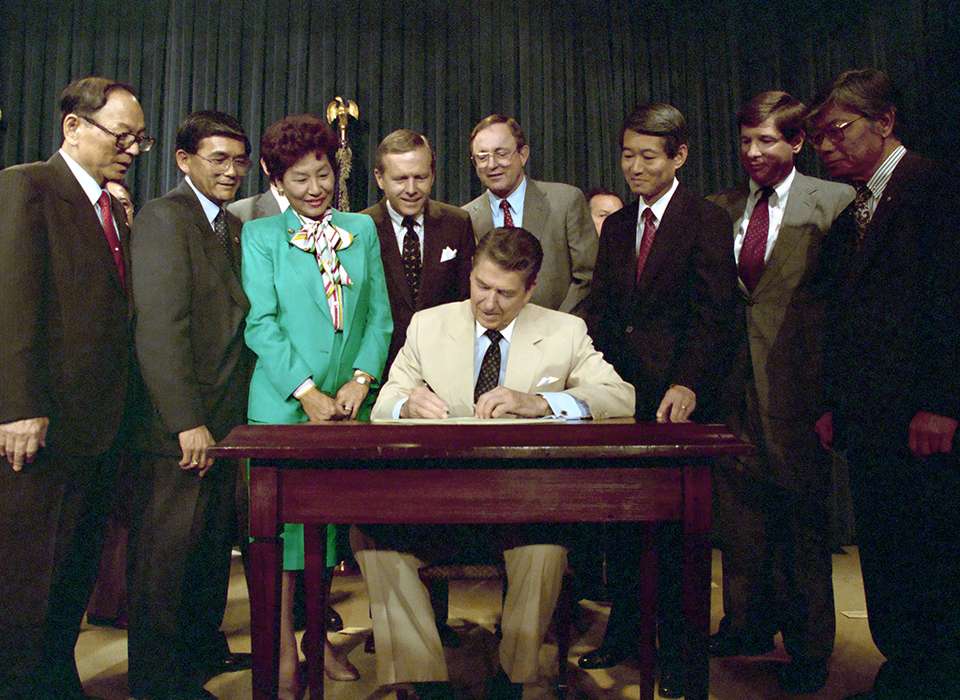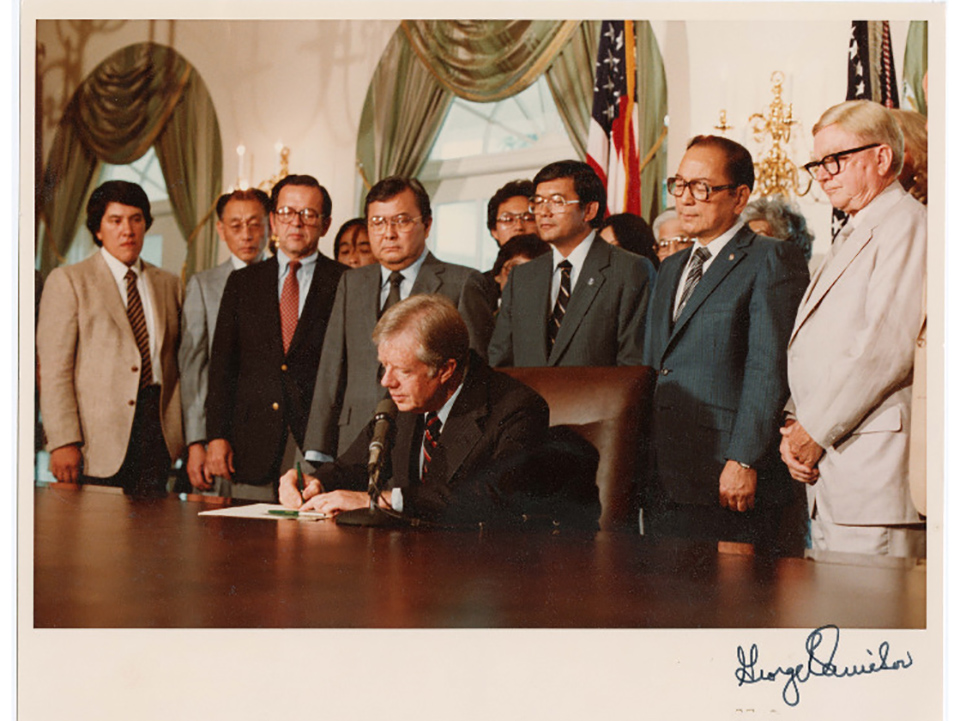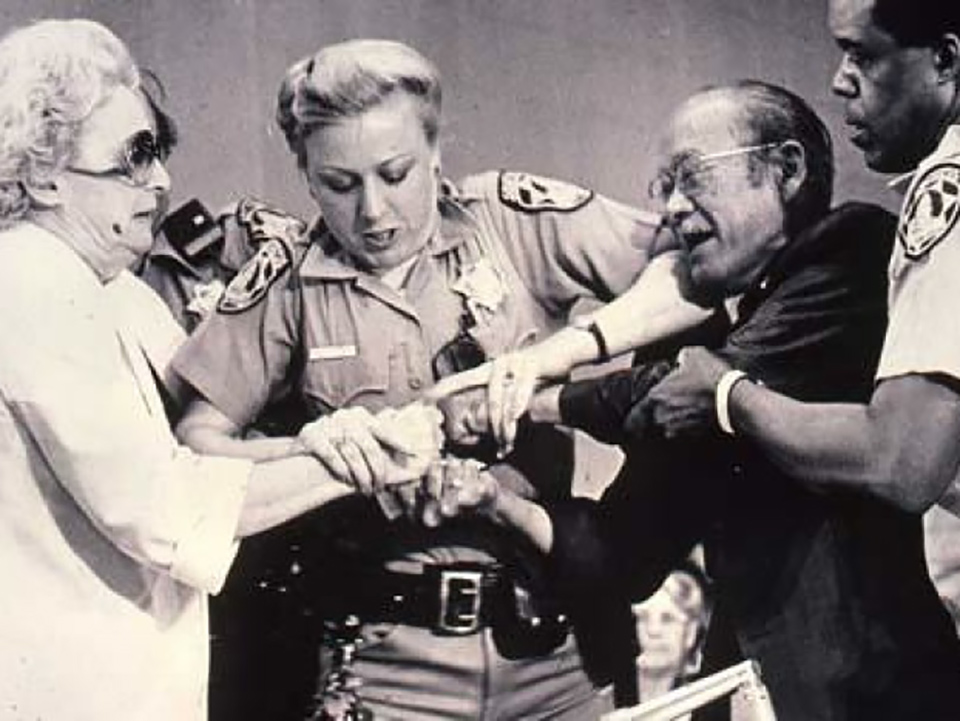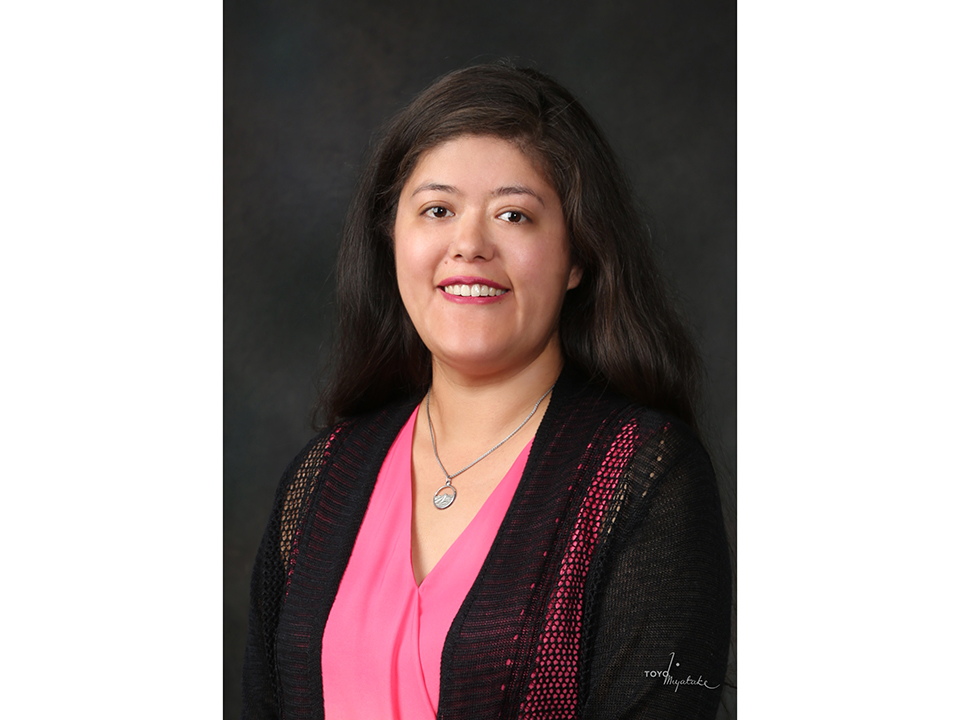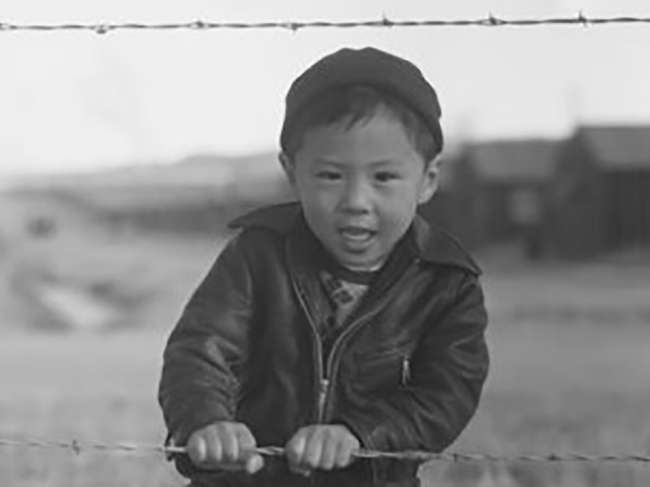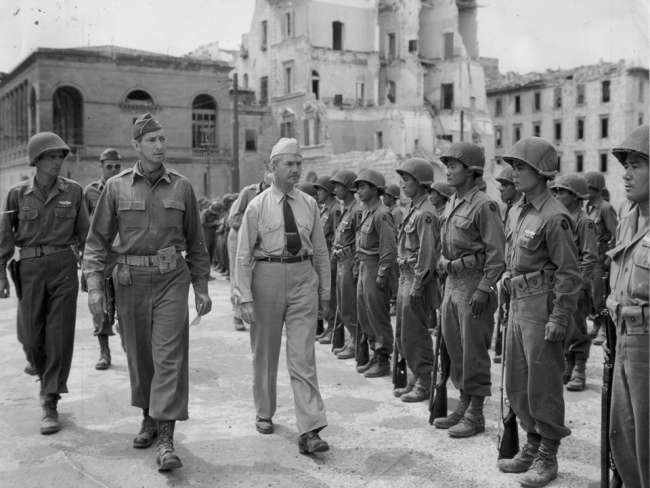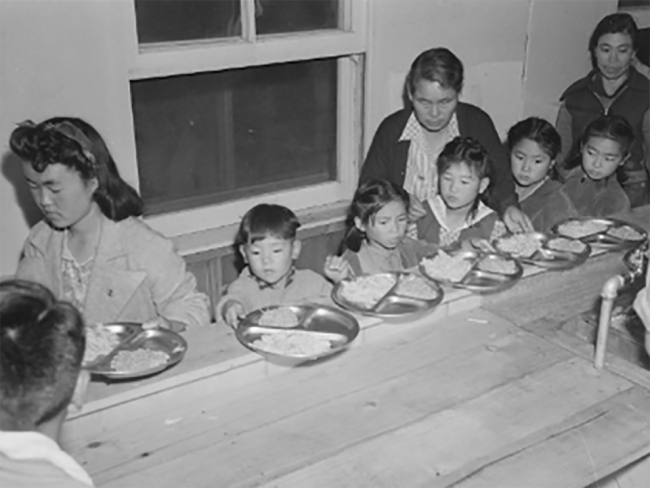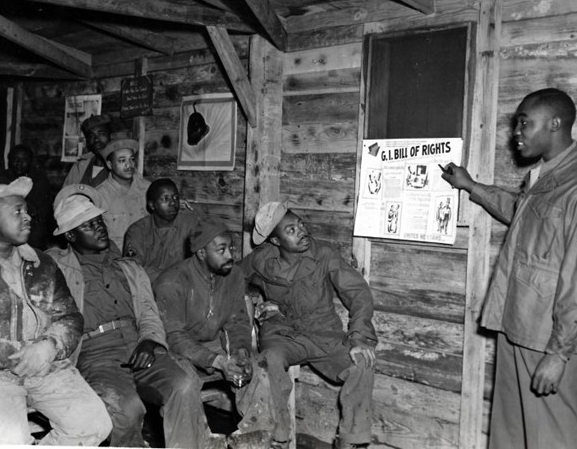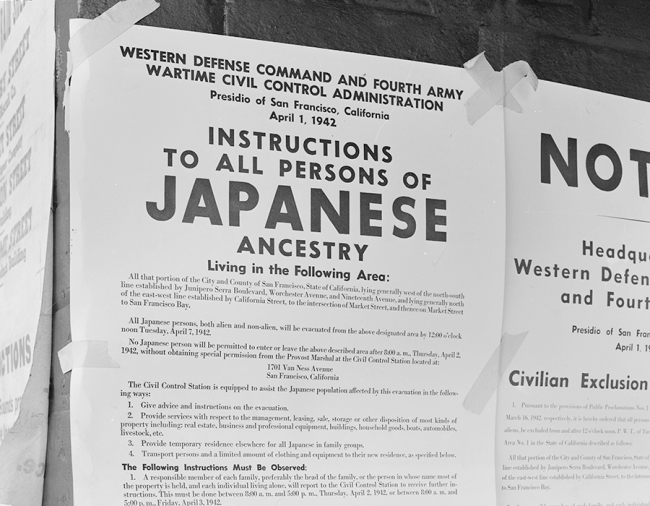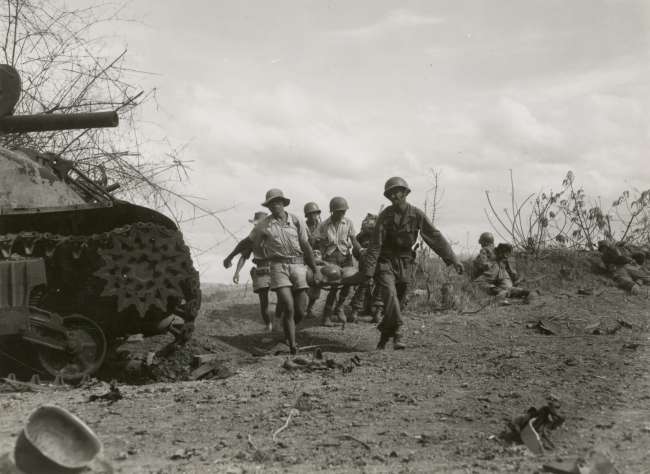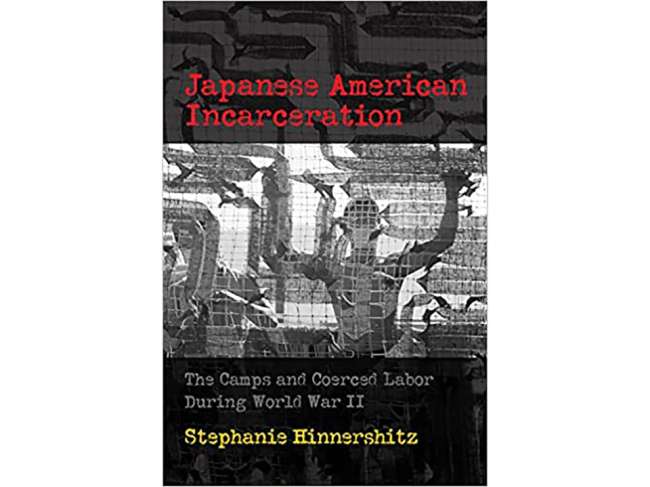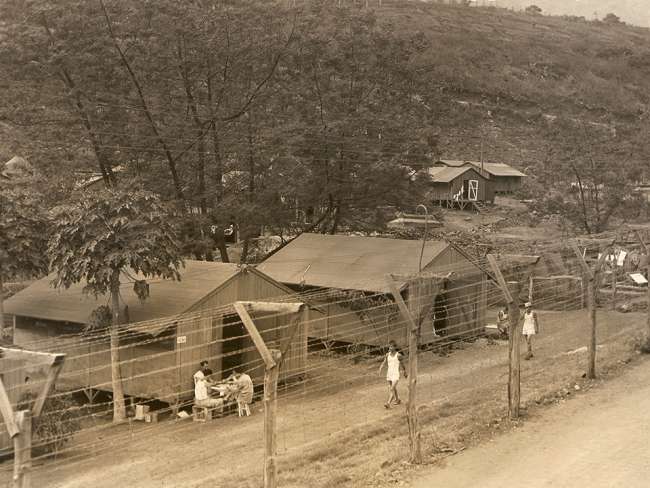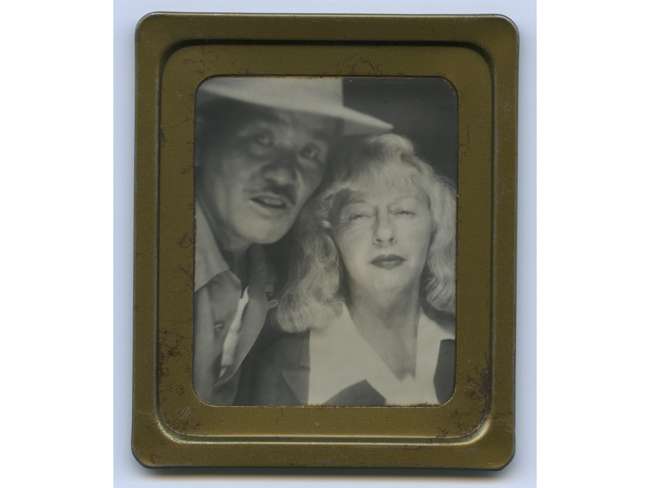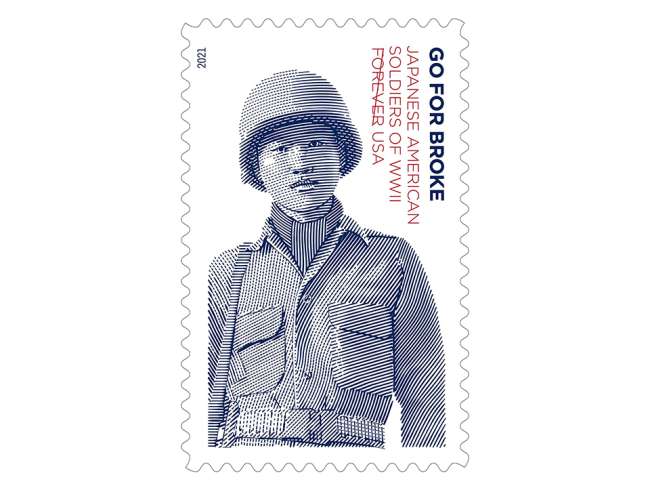Top Image: President Ronald Reagan Signs The Reparations Bill for Japanese Americans with Pete Wilson Spark Matsunaga, Norman Mineta, Robert Masui, and Bill Lowrey. The National Archives, photo no. 75856233.
Amy Iwasaki Mass was only a girl when her family was imprisoned in a camp built at the foot of an upside-down mountain in northwest Wyoming during World War II. Comprised of limestone that is several hundred million years old, Heart Mountain stands upon much younger rocks. Over 300 million years ago, northwest Wyoming was a tropical sea layered with limestone and ancient dolomite and granite. Heart Mountain formed when the ancient rocks were raised and upended, causing a massive sheet of limestone to separate and slide southeast. The sheet splintered into hunks and rested upon rocks that are about 55 million years old.
Originally part of the Apsáalooke (Crow) tribe’s homelands, the Heart Mountain Relocation Center was one of 10 camps that incarcerated 120,000 Japanese Americans in Arkansas, Arizona, California, Colorado, Idaho, Utah, and Wyoming. The first incarcerees arrived on August 12, 1942 to drafty barracks furnished with an overhead light, stove, and army cots. The Iwasakis arrived during the first week of September 1942.
“My family bought camp chairs with colorful lined seats on them because they were things we could fold up and carry,” said Mass to her grandson in the Museum’s 2021 Electronic Field Trip, Japanese American Experiences in World War II. “It gave me the idea that camp was going to be a rustic, quiet, calm place to go to. Well, it wasn’t. It turned out to be there was no foliage. It was all tumbleweeds and a lot of dust flying around. And our house was one room with six cots and a potbelly stove that we could use to keep us warm.”
Since there was no insulation or privacy, incarcerees stuffed cracks with newspaper and rags and strung up sheets to keep the harsh weather out. Noise traveled easily within the barracks because the partitions did not touch the ceiling. Mass learned the concept of gaman in camp, which she described as “the way Japanese were known for being very stoic and resilient and brave in the face of hardship.”
“If we wanted to be good children, we were not allowed to have a tantrum or kick and scream and act nasty to our parents or anything like that because everybody could hear us next door. And the favorite social activity in camp was gossip so that would mean if you are acting bad everybody would find out about it,” Mass said.
While gaman helped instill good behavior in the young incarcerees, making friends with children their own age helped them get through daily life. Former US Secretary of Transportation and Congressman Norman Mineta and former Wyoming Senator Alan Simpson describe how they met during a Boy Scout jamboree at Heart Mountain in oral history interviews with The National WWII Museum.
“So this kid and I built a great moat around our tent and he said, ‘There’s a kid from my troop in that tent below us. I don’t really care for him. Would you mind if we cut the water to exit that way?’ It was no skin off my nose. So I said, ‘Sure’ We cut the water to exit that way,” said Norman Mineta in his oral history.
“We set up a tent and did our tent work, and then we got bullied by this guy, and we got above him in a kind of a topography there and it began to rain and we directed our overflow water to his tent,” said Alan Simpson in his oral history.
“Went to the tent below us. Tent pegs pulled up on that tent. Tent came down. The kid in my tent [was] going, hee hee hee. Haw haw haw. Ho ho ho. Just laughing,” said Mineta. “It was a wonderful thing, and he said that I cackled. I think that’s not true. I may have chuckled. But anyway, both of us, it was funny as hell,” said Simpson.
Heart Mountain closed on November 10, 1945. As veterans returned from the war, the US government held three lotteries for prospective homesteaders from 1947 to 1949. Wyoming homesteaders moved into the Heart Mountain barracks, living at the former prison camp until they were assigned homestead properties and sold a barrack for a dollar. Barracks were cut into halves or thirds and used as sheds, storage units, or homes. Although they were repurposed, Japanese Americans did not forget their years spent in them. For many, their wartime experiences affected them years after they were free of barbed wire.
Mass’s experiences led her to become a clinical social worker and participate in the redress movement that culminated with the passage of the Civil Liberties Act of 1988. This law gave surviving Japanese Americans $20,000 in reparations and a formal apology by President Reagan for their incarceration during World War II. But its passage did not happen overnight. It took years to turn the redress movement into legislation.
In 1978, the Japanese American Citizens League (JACL) formed the Redress Committee and appointed John Tateishi as its chair. The JACL and Tateishi went to the Hill to meet with California Representatives Mineta and Robert Matsui, as well as Senators Daniel Inouye and Spark Matsunaga. Like Inouye, Matsunaga was a WWII veteran. He fought in the 100th Infantry Battalion and the 442nd Regimental Combat Team. They began their political careers together when they were elected to the Hawaii Territorial House of Representatives in 1954. The JACL Redress Committee assumed the congressmen would agree with their idea for reparations. Inouye convinced them to switch from pursuing monetary compensation to creating a federal commission to investigate the causes and consequences of the incarceration.
Jimmy Carter signs the Commission on Wartime Relocation and Internment of Citizens Act into law. Courtesy of the Ron Ikejiri Collection, Densho Encyclopedia.
On August 2, 1979, Inouye and Matsunaga introduced Senate bill 1647 to establish the Commission on Wartime Relocation and Internment of Civilians (CWRIC). In 1980, Congress and President Carter signed that bill into law. The CWRIC gathered archival sources, scholarship, and personal papers that explained the government’s decision and process for incarceration. The Commission also held 20 days of hearings. Over 750 policy makers and incarcerees in Washington DC, Los Angeles, San Francisco, Seattle, Chicago, New York, and Boston shared their experiences from July to December 1981. But not everyone supported the Commission.
The National Council for Japanese American Redress (NCJAR) formed in 1979 and challenged the JACL redress leadership by supporting a bill that demanded $15,000 in reparations and $15 for each day of incarceration. When the bill died in Congress, NCJAR filed a lawsuit in 1983 that demanded $220,000 in reparations. When the US Supreme Court heard it in 1986, they recommended that the case be heard by the US Court of Appeals for the Federal Circuit. When it was dismissed in that court, the US Supreme Court declined to reconsider it and NCJAR’s redress efforts ended in 1988.
The National Coalition for Redress/ Reparations (NCRR) was a Sansei (the children of children born to ethnic Japanese in a new country of residence)-led grassroots effort for inclusion in the Commission hearings. Afraid that the hearings would be restricted to the JACL community, they encouraged working class and non-English language speaking incarcerees to testify. Their efforts culminated in an evening hearing in Los Angeles and translators at the Los Angeles and San Francisco hearings. Mass testified at the Los Angeles hearings as a member of a mental health panel on August 6, 1981.
“It was interesting because it was not something that was popular among everybody. And I guess the fact that I had been talking to my students, to my patients, and reading about other people’s experiences with camp, I knew what a profound effect it had on all of us and so I knew that was important to talk about even though it wasn’t popular to talk about,” Mass said.
To prepare, she attended the Los Angeles hearings days before her testimony.
“Lillian Baker, who is very anti-Japanese, was at that meeting. And although I didn’t come to the meetings until after she left, it was the day when she got so upset by some man who was giving a speech, she ran up to him and grabbed his papers. The sheriff had to come and take her away. I didn’t see her, but when I went as part of my preparation, I sat next to the women who were supporting her. When you see the hatred of somebody directed at you—and I was sitting very close to them—I thought to myself, it’s that kind of dedicated hatred that got us into the camp.”
Officers assist Jim Kawaminami to stop Lillian Baker from trying to take his papers and the redress hearings, 1981, Los Angeles, California. Courtesy of Densho Encyclopedia.
On February 24, 1983 the CWRIC issued its report Personal Justice Denied. It concluded that Executive Order 9066 “was not justified by military necessity, and the decisions which followed from it—detention, ending detention and ending exclusion—were not driven by analysis of military conditions. The broad historical causes which shaped these decisions were race prejudice, war hysteria, and failure of political leadership.”
On June 16, 1983, the CWRIC published its recommendations. It proposed an apology from the federal government, presidential pardons for those convicted of curfew and exclusion violations, a request that federal agencies review applications for restitution related to incarceration, and recommended that the government establish a foundation for research and public education on WWII incarceration.
The Civil Liberties Act of 1988 was signed into law on August 10, 1988, and implemented the recommendations of the CWRIC. Throughout his time in office, Senator Matsunaga supported civil rights for Asian Americans and was the primary advocate for the Civil Liberties Act. He personally talked to each of his colleagues in the Senate about how their support could help address the unjustness of the incarceration. His experience as a veteran, good-natured personality, and strong work ethic all helped him garner 75 cosponsors for the act. According to Leslie T. Hatamiya in Righting a Wrong: Japanese Americans and the Passage of the Civil Liberties Act of 1988 “Matsunaga’s efforts cannot be overemphasized.”
In an oral history interview with The National WWII Museum, Mineta recalls how he and Simpson worked with Democrats and Republicans to get the Civil Liberties Act passed:
“I think for the Japanese American community, they shouldered the yoke of the evacuation and internment in 1942. And I think that yoke was finally lifted,” said Mineta about that day 33 years ago.
Today, Mass, Mineta, and Simpson are on the Advisory Council of the Heart Mountain Wyoming Foundation. The Foundation preserves the personal stories, visual histories, and artifacts of Heart Mountain incarcerees. It also preserves the original site of the camp and hosts annual pilgrimages. Mass has returned to Heart Mountain several times since the end of World War II. When she returned for the first time, she was on the way to Yellowstone National Park for vacation with her husband and young children.
“I didn’t miss the fact that the camp was not there. I didn’t miss the barracks not being there. But I was very moved by the fact that Heart Mountain was still there. That this mountain, this very large, strong mountain was still there.”In recent years, she’s returned to Heart Mountain for the annual pilgrimages. “It made me feel really good that this was an opportunity for my family to learn and grow and really understand their history.”
Meet the Author
Helen Yoshida is a consultant, oral historian, and writer. She received her Master’s degree in History from California State University Fullerton (CSUF) and her Bachelor’s degree in English from the University of California Irvine (UCI). She is currently the Oral History Interviewer and Research Assistant for the Documenting the Experiences of Mexican, Filipina, and Chicana Women in California Agriculture oral history project at CSUF’s Lawrence de Graaf Center for Oral and Public History (COPH). Previously, she worked for the National Education Association, Education Week, and the Heart Mountain Wyoming Foundation in Washington DC. Her writing has appeared in The Atlantic, Education Week, Kokoro Kara, NEA Today, The Oral History Review, Oral History Review Blog, COPH Biennial Report, and the UCI School of Humanities, among others. She currently lives in Southern California.
Cite this article:
MLA Citation:
APA Citation:
Chicago Style Citation:
